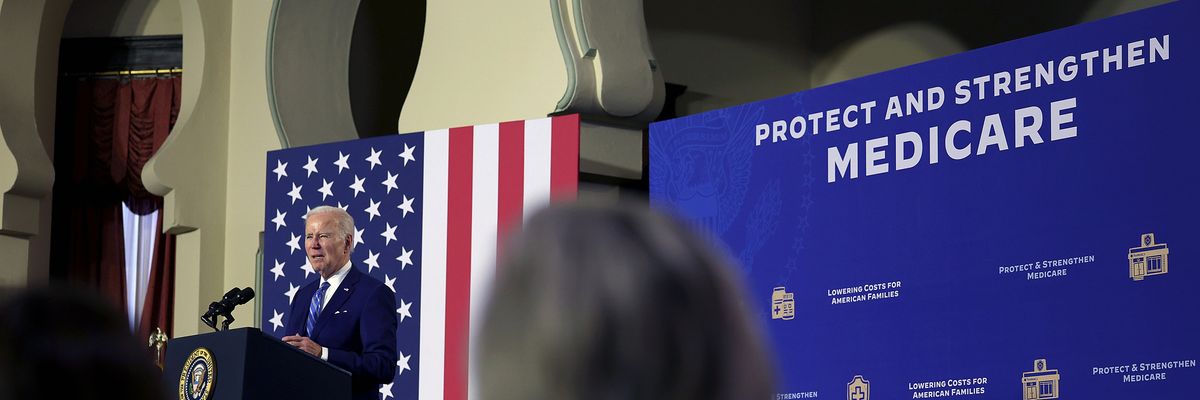President Lyndon Johnson
signed Medicare into law 58 years ago Sunday—on July 30, 1965. Before Medicare, most American seniors could not obtain health insurance; they had to rely on charity or help from relatives with medical bills.
"Millions of our citizens do not now have a full measure of opportunity to achieve and to enjoy good health. Millions do not now have protection or security against the economic effects of sickness,” said President Johnson at the signing ceremony. “And the time has now arrived to help them attain that opportunity and to help them get that protection."
Medicare was
modeled on a typical Blue Cross/Blue Shield plan in 1965. The average health insurance plan 58 years ago did not include hearing, vision, or dental coverage. As Kaiser Health News points out, “Back in 1965, life expectancy was lower and health care (including dental) was more affordable.”
“When Medicare was created, its architects assumed expansion… in terms of benefits. (But) they didn’t anticipate the shift in American politics to the right.”
Today, life expectancy is longer and healthcare costs have skyrocketed. But traditional Medicare still does not cover hearing, vision, and dental care—leaving beneficiaries to bear the full cost of care for their ears, eyes, and teeth. Hearing aids, dental crowns, and eyeglasses can amount to thousands of dollars in out-of-pocket expenses, which many seniors simply can’t afford.
President Joe Biden’s original
Build Back Better plan finally would have added hearing, vision, and dental coverage to traditional Medicare. The White House ultimately dropped dental and vision care from its plan after objections from Democratic centrists, leaving hearing coverage as the only potential benefit expansion. Then, the entire Build Back Better plan was killed at the end of 2021 when Senator Joe Manchin (D-W.Va.) withdrew his support, effectively ending any real chance to expand traditional Medicare benefits while Democrats controlled the White House and both houses of Congress.
As Jonathan Oberlander, professor of health policy at UNC-Chapel Hill,
observed, “Medicare is the kind of program where you’d expect the benefits to be expanded over and over again.” But other than the addition of Part D prescription drug coverage (administered by private plans) in 2003, Medicare benefits have not been expanded in the 58 years since the program was enacted.
“When Medicare was created, its architects assumed expansion… in terms of benefits,” Oberlander told
Kaiser Health News. “(But) they didn’t anticipate the shift in American politics to the right.” This shift, which took root with the election of Ronald Reagan in 1981, emphasized tax cuts for the wealthy and corporations, increased military spending, and spouted a lot of bluster about reducing deficits (hard to accomplish given the first two items on the list).
What President Biden called
“human infrastructure”—services for everyday Americans struggling to thrive in a global economy amid growing wealth inequality—became a tougher political sell after 1981. The ill-fated Build Back Better plan was an earnest attempt to begin investing more resources in “human infrastructure.” Despite the demise of Build Back Better, we should not give up on expanding traditional Medicare. Real change takes time and persistence.
In fact, there has been real progress on Medicare in other ways. The
Inflation Reduction Act (the reconstituted version of Build Back Better) finally allows Medicare to negotiate prescription drug prices with Big Pharma—an historic reform that took some 20 years to enact. The Inflation Reduction Act will cap beneficiaries’ out of pocket drug costs at $2,000 per year (starting in 2025), limits seniors’ insulin costs to $35 a month, and penalizes drug-makers for raising prices above the rate of inflation.
While Congress was unable to enact a hearing benefit for traditional Medicare enrollees,
legislation introduced by Senators Elizabeth Warren (D-Mass.) and Chuck Grassley (R-Iowa) required the Food & Drug Administration (FDA) to create a rule greatly expanding access to over-the-counter (OTC) hearing aids, which the FDA did in 2022. These OTC products (suitable for mild-to-moderate hearing loss) can be significantly less expensive than prescription hearing aids. And while the president’s proposed dental benefit for traditional Medicare did not survive the legislative process, the Biden administration has expanded the definition of “medically necessary” dental care under Medicare Part B.
A 2021 study by Kaiser Family Foundation indicated that MA customers “still generally end up with significant out-of-pocket costs” for hearing, dental, and vision care.
Some
Medicare Advantage (MA) plans do offer hearing, dental, and vision coverage—but those benefits are extremely modest and don’t always make up for the disadvantages of Medicare Advantage. Many MA insurers are under investigation for overbilling the government, denying authorizations for reasonable medical procedures, and misleading customers through celebrity ad campaigns. Meanwhile, Medicare Advantage plans restrict beneficiaries to limited networks of providers and sometimes don’t cover medical care outside of a patient’s home region.
A 2021 study by
Kaiser Family Foundation indicated that MA customers “still generally end up with significant out-of-pocket costs” for hearing, dental, and vision care. “It stands to reason there would be lower out-of-pocket spending in Medicare Advantage than in traditional Medicare, but the differences are not as large as one might expect,” Tricia Neuman, a senior vice president at Kaiser Family Foundation, told Kaiser Health News.
These privatized Medicare plans, which unfortunately are growing in market share under the power of their advertising (boosted by a
pro-MA bias during the Trump administration), were not part of the original vision for Medicare when President Johnson signed it into law. Traditional Medicare is the bedrock program which has provided seniors with health security since 1965. It must be preserved—and expanded—in accordance with the real needs of 21st century seniors.
On this 58th anniversary of Medicare, let’s recommit to President Johnson’s promise of the “opportunity to achieve and enjoy good health” and provide “security against the economic effects of sickness.”

